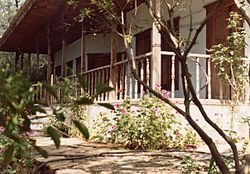Akyaka, Muğla
| Akyaka | |
|---|---|

Arch. Nail Çakırhan own house in Akyaka, recipient of 1983 Aga Khan Award for Architecture
|
|
 Location of Akyaka, Muğla within Turkey. |
|
| Location of Akyaka, Muğla within Turkey. | |
| Coordinates: 37°03′N 28°19′E / 37.050°N 28.317°ECoordinates: 37°03′N 28°19′E / 37.050°N 28.317°E | |
| Country |
|
| Region | Aegean |
| Province | Muğla |
| Time zone | EET (UTC+2) |
| • Summer (DST) | EEST (UTC+3) |
| Postal code | 48x xx |
| Area code(s) | (0090)+ 252 |
| Licence plate | 48 |
| Website | www.akyaka.bel.tr |
Akyaka is a coastal township with its own municipality in the Ula district of Muğla Province in southwestern Turkey. The town is situated at the far end of the Gulf of Gökova, at the start of the fertile Gökova plain, and is a rising center for international tourism due to its advantageous location and natural beauties. It is the first coastal town encountered on the busy road from the province center of Muğla to the better known resort center of Marmaris, and it comes into sight, along with a spectacular view of the gulf and the plain, some thirty miles after departure from Muğla at Sakar Pass, a favorite paragliders' spot where the road descends from an altitude of 670 m. to sea-level in the space of a pine-clad section of a dozen kilometers along very sharp curves. At the base of the hill is the intersection to Akyaka.
Locally and casually, erroneously and confusingly, the township of Akyaka is sometimes referred to as Gökova, after the name of the gulf and the plain, while there is also an inland township of Gökova neighbouring Akyaka, itself of visitor's interest and whose intersection is slightly further ahead from that of Akyaka in the direction of Marmaris.
Much of the Gökova plain had been unproductive for centuries, until the later half of the 20th century, and was covered with marshlands ridden with malaria. The inhabitants abandoned their settlements and fields entirely during the months of active malaria and moved to highland plateaus (yayla). The arable land available was usually owned by large landowners from the district center of Ula. An organized program to combat malaria, one of the priorities of the young Turkish Republic of the 1920s, was enacted under a specific law in 1926, in the frame of which ownership titles were awarded to individuals or groups of people on the basis of the swampland they drained, and were quite successful in the transformation of Akyaka region, especially through the local projects lasting from 1925 to 1940. In the following decades, conversion of fields for cash crops, particularly tobacco, dominated the local economy and this until the 1970s when the first steps in the tourism industry were taken. Akyaka became quite cosmopolitan in recent years.
...
Wikipedia

